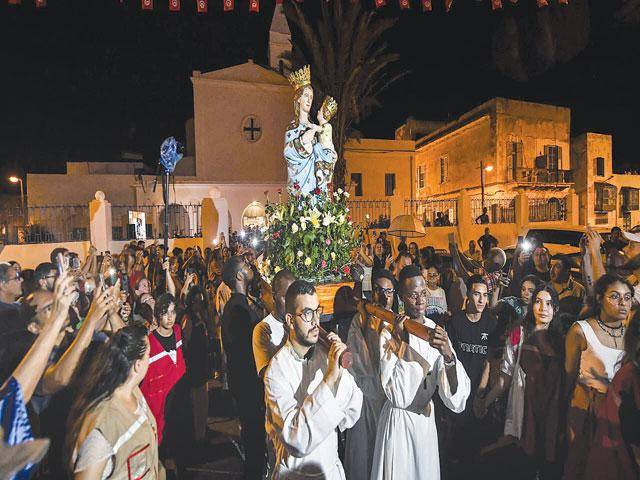LA GOULETTE - Worshippers crying “Hail Mary” walk alongside their Muslim neighbours in the Tunisian port district of La Goulette, harking back to a time when Sicilians were at the heart of neighbourhood life. The Madonna of Trapani procession, marking the Catholic Feast of the Assumption, is an echo of a “forgotten history” researchers of Italian origin say offers a model for coexistence with migrants, among faiths and ethnicities. The annual procession was born in the mid-19th century when La Goulette was home to tens of thousands of Sicilians, as well as Sephardic Jews, Maltese, Greeks and Spaniards. “They shared each other’s celebrations and sadnesses, and took part in each other’s events”, said Silvia Finzi, editor of Italian-language Tunisian newspaper Corriere di Tunisi -- one of some 120 Italian publications founded between 1838 and 1956, the year Tunisia gained independence from France. There were some red lines -- for example, there were few marriages across religious divides.But for centuries, Tunisia has been able to peacefully host a mosaic of migrant communities “without forcing them to forget their roots”, Finzi said.
The Madonna of Trapani procession started after Tunisia’s Muslim ruler Ahmed Bey -- whose mother was a Sardinian Christian -- gave a piece of land for the building of a church in 1848.
It was Sicilian fishermen from La Goulette, a port district on the edge of Tunis, who started the annual procession from the church to the sea to mark the Feast of the Assumption on August 15 and pray for a good catch and protection on the high seas. The mariners lived among Muslims and Jews in a part of La Goulette nicknamed “Little Sicily”.
Trapani is a city in the northwest of the Italian island. The procession was suspended in 1964 following Tunisia’s independence from France, but was relaunched in 2017.
This year it attracted hundreds of Christians, Muslims and the mayors of Tunis and La Goulette.
The Madonna of Trapani procession started after Tunisia’s Muslim ruler Ahmed Bey -- whose mother was a Sardinian Christian -- gave a piece of land for the building of a church in 1848.
It was Sicilian fishermen from La Goulette, a port district on the edge of Tunis, who started the annual procession from the church to the sea to mark the Feast of the Assumption on August 15 and pray for a good catch and protection on the high seas. The mariners lived among Muslims and Jews in a part of La Goulette nicknamed “Little Sicily”.
Trapani is a city in the northwest of the Italian island. The procession was suspended in 1964 following Tunisia’s independence from France, but was relaunched in 2017.
This year it attracted hundreds of Christians, Muslims and the mayors of Tunis and La Goulette.






